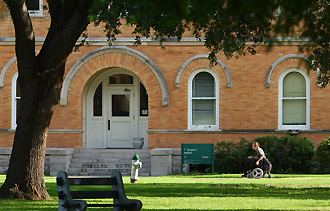Task Force Targets Campus Accessibility
Broken concrete on a sidewalk, a building without a ramp, a large planter that blocks access to a building. A work group surveying the accessibility of buildings on Tulane's uptown campus is looking at these and other impediments that can affect the daily lives of people with disabilities.

A work group is surveying campus accessibility for people with disabilities. (Photo by Paula Burch-Celentano)
At the request of Tulane President Scott Cowen, the Office of Institutional Equity in spring 2008 formed the Access Management Work Group, a committee of 14 faculty members, staff and students that is engaged in the process of identifying and prioritizing access needs on the uptown campus.
Cowen and Yvette Jones, senior vice president for external affairs and chief operating officer, “saw the need for Tulane to be more proactive in our review of campus access issues,” said Deborah Love, vice president of the Office of Institutional Equity.
The work group is being assisted by Kessels Diboll Kessels Architects, a New Orleans firm that has provided an accessibility survey of existing site conditions that illustrates routes of access on the uptown campus, along with areas that may pose problems for people with disabilities.
While the report will help the work group identify problem areas, the purpose of the report is descriptive and does not make recommendations, says Michael Kuczynski, an associate professor of English who serves on the committee.
Kuczynski says the report, a second draft of which was delivered to the work group last Friday (Sept. 26), indicates that issues of access on campus are “better than they are worse.” In some instances such as a patch of broken concrete along Audubon Boulevard or a non-functioning button on an automatic door in the Norman Mayer building the problem is easy to fix. The remediation of other obstructions may be more complicated and expensive.
In some cases the issue is simply that routes of access are poorly labeled, adds Kuczynski, who also chairs a task force subcommittee on campus signage. Other task force subcommittees are reviewing best practices of peer institutions, federal policy and regulatory changes and university reporting practices and procedures.
“We've made real strides in the last decade to make the university more diverse, to establish a level playing field and to make our older buildings compliant with the ADA (Americans With Disabilities Act) regulations,” Kuczynski says. “There are all kinds of reasons, including risk management, to make the university maximally accessible. But that's not what is driving this initiative. It's the right thing to do.”
According to Love, the work group expects to have a report identifying and prioritizing the uptown campus' access needs by spring 2009.
Anyone with questions about the Access Management Work Group or its efforts should e-mail Michael Kuczynski.
